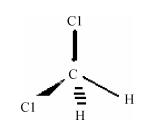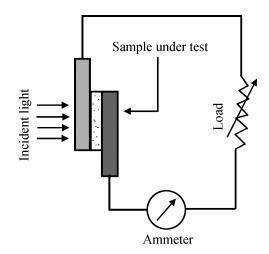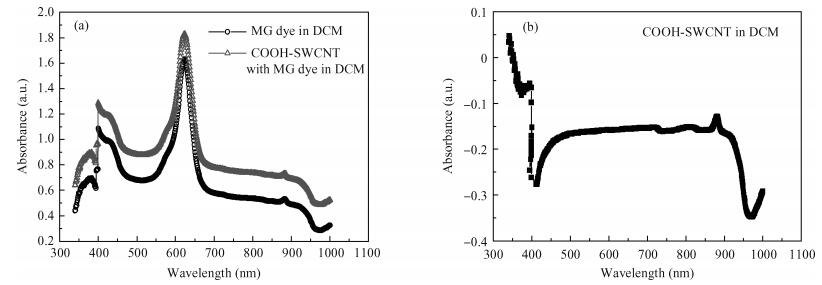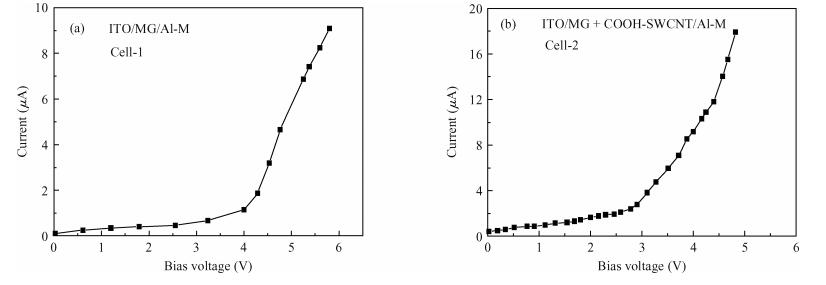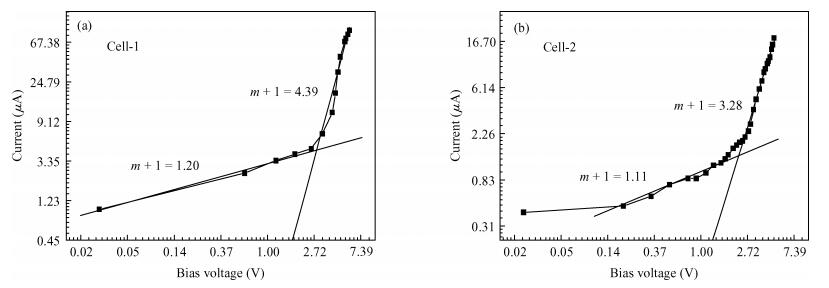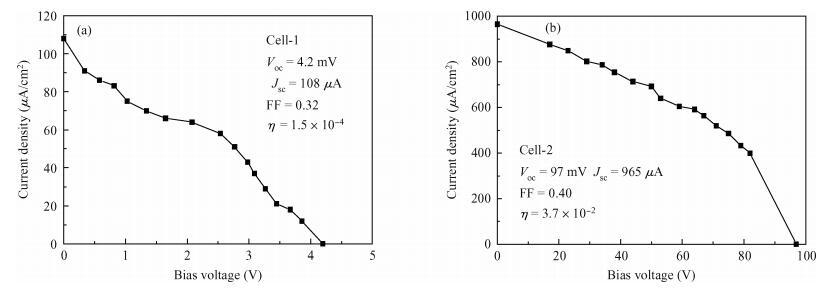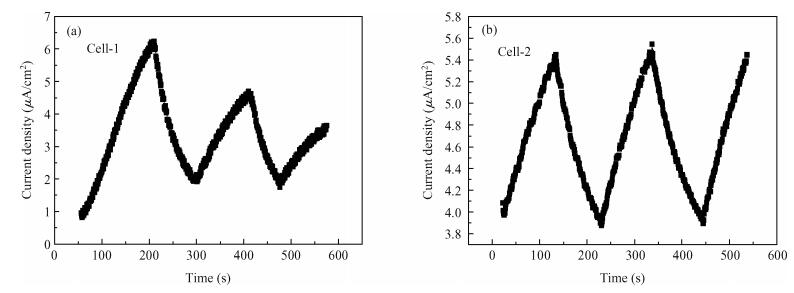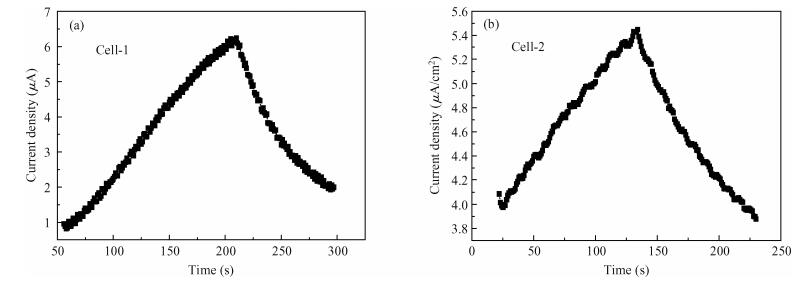| Citation: |
S. Chakraborty, N.B. Manik. Effect of COOH-functionalized SWCNT addition on the electrical and photovoltaic characteristics of Malachite Green dye based photovoltaic cells[J]. Journal of Semiconductors, 2014, 35(12): 124004. doi: 10.1088/1674-4926/35/12/124004
****
S. Chakraborty, N.B. Manik. Effect of COOH-functionalized SWCNT addition on the electrical and photovoltaic characteristics of Malachite Green dye based photovoltaic cells[J]. J. Semicond., 2014, 35(12): 124004. doi: 10.1088/1674-4926/35/12/124004.
|
Effect of COOH-functionalized SWCNT addition on the electrical and photovoltaic characteristics of Malachite Green dye based photovoltaic cells
DOI: 10.1088/1674-4926/35/12/124004
More Information
-
Abstract
We report the effect of COOH-functionalized single walled carbon nanotubes (COOH-SWCNT) on the electrical and photovoltaic characteristics of Malachite Green (MG) dye based photovoltaic cells. Two different types of photovoltaic cells were prepared, one with MG dye and another by incorporating COOH-SWCNT with this dye. Cells were characterized through different electrical and photovoltaic measurements including photocurrent measurements with pulsed radiation. From the dark current-voltage (I-V) characteristic results, we observed a certain transition voltage (Vth) for both the cells beyond which the conduction mechanism of the cells change sharply. For the MG dye, Vth is 3.9 V whereas for COOH-SWCNT mixed with this dye, Vth drops to 2.7 V. The device performance improves due to the incorporation of COOH-SWCNT. The open circuit voltage (Voc) and short circuit current density change from 4.2 to 97 mV and from 108 to 965 μA/cm2 respectively. Observations from photocurrent measurements show that the rate of growth and decay of the photocurrent are quite faster in the presence of COOH-SWCNT. This observation indicates a faster charge separation processes due to the incorporation of COOH-SWCNT in the MG dye cells. The high aspect ratio of COOH-SWCNT allows efficient conduction pathways for the generated charge carriers.-
Keywords:
- MG dye,
- COOH-SWCNT,
- photovoltaic devices,
- charge transport
-
References
[1] Hoppe H, Sariciftci N S. Organic solar cells:an overview. J Mater Res, 2004, 19(7):1924 doi: 10.1557/JMR.2004.0252[2] Saha S, Manik N B. Study of solvent dependence of Methyl Red and C60 based organic photovoltaic devices. Thin Solid Films, 2012, 520:6274 doi: 10.1016/j.tsf.2012.05.081[3] Hoope H, Niggemann M, Winder C, et al. Nanoscale morphology of conjugated polymer/fullerene-based bulk-heterojunction solar cells. Adv Funct Mater, 2004, 14(10):1005 doi: 10.1002/(ISSN)1616-3028[4] Maity S, Halder A, Manik N B. Effect of plasticizer on safranine-T-dye-based solid-state photo electrochemical cell. Ionics, 2008, 14:549 doi: 10.1007/s11581-008-0217-0[5] Kawano K, Sakai J, Yahiro M, et al. Effect of solvent on fabrication of active layers in organic solar cells based on poly(3-hexylthiophene) and fullerene derivatives. Sol Energy Mater Sol Cells, 2009, 93(4):514 doi: 10.1016/j.solmat.2008.11.003[6] Shaheen S E, Brabec C J, Sariciftci N S. 2.5% efficient organic plastic solar cells. Appl Phys Lett, 2001, 78(6):841 doi: 10.1063/1.1345834[7] Yuan Yujie, Hou Guofu, Zhang Jianjun, et al. Optimization of n/i and i/p buffer layers in n-i-p hydrogenated microcrystalline silicon solar cells. Journal of Semiconductors, 2009, 30(3):0340071 http://www.jos.ac.cn/bdtxbcn/ch/reader/view_abstract.aspx?file_no=08062501&flag=1[8] Saha S, Manik N B. Enhancement of efficiency of phenosafranin based organic photovoltaic devices using nano particles. Indian J Phys, 2012, 86(7):605 doi: 10.1007/s12648-012-0090-6[9] Lee D, Bae K W, Park I, et al. Transparent electrode with ZnO nanoparticles in tandem organic solar cells. Solar Energy Materials & Solar Cells, 2011, 95:365[10] Li Ying, Feng Shiwei, Yang Ji, et al. Photoresponse of ZnO single crystal film. Chinese Journal of Semiconductors, 2006, 27(6):96[11] Wang S H, Hsiao Y J, Fang T H, et al. Enhancing performance and nanomecahnical properties of carbon nanotube doped P3HT:PCBM solar cells. ECS Journal of Solid State Science and Technology, 2013, 2(11):M52 doi: 10.1149/2.038311jss[12] Kymakis E, Amaratunga G A J. Single-wall carbon nanotubes/conjugated polymer photovoltaic devices. Appl Phys Lett, 2002, 80:112 doi: 10.1063/1.1428416[13] Nismy N A, Jayawardena K D G I, Damitha A A, et al. Photoluminescence quenching in carbon nanotube-polymer/fullerene films:carbon nanotubes as exciton dissociation centres in organic photovoltaics. Adv Mater, 2011, 23(33):3796[14] Huang S M, Woodson M, Smalley R, et al. Growth mechanism of oriented long single walled carbon nanotubes using "fast-heating" chemical vapor deposition process. Nano Lett, 2004, 4(6):1025 doi: 10.1021/nl049691d[15] Daniel T D, Benjamin F S, James Q S, et al. Single walled carbon nanotube network electrodes for dye solar cells. Solar Energy Materials & Solar Cells, 2010, 94:1665[16] Savita S P, Prakash S R, Umeno M. Characterization of doped and undoped CVD-diamond films by cathodoluminescence. Diamond & Related Materials, 2008, 17:585[17] Zhu H W, Wei J Q, Wang K L, et al. Applications of carbon nanotubes in photovoltaic solar cells. Solar Energy Materials & Solar Cells, 2009, 93:1461[18] Yong K H, Lars M M, Alexander Z A, et al. Semi-transparent small molecule organic solar cells with laminated free-standing carbon nanotube top electrodes. Solar Energy Materials & Solar Cells, 2012, 96:244[19] Ajanta H, Subhasis M, Manik N B. Effect of back electrode on photovoltaic properties of crystal-violet-dye-doped solid-state thin film. Ionics, 2008:427[20] Adina R, Alexendra O, Mihaela P, et al. Influence of surfactants on the fading of malachite green. Cent Eur J Chem, 2008, 6(1):89[21] Mathew M W, Simina P N, Joseph S G. Measurement of functionalized carbon nanotube carboxylic acid groups using a simple chemical process. Carbon, 2006, 44:1137 doi: 10.1016/j.carbon.2005.11.010[22] Yang J, Shen J. Effects of discrete trap levels on organic light emitting diodes. J Appl Phys, 1999, 85(5):2699 doi: 10.1063/1.369587[23] Kymakis E, Amaratunga J A G. Single-wall carbon nanotube/conjugated polymer photovoltaic devices. Appl Phys Lett, 2002, 80(1):112 doi: 10.1063/1.1428416 -
Proportional views





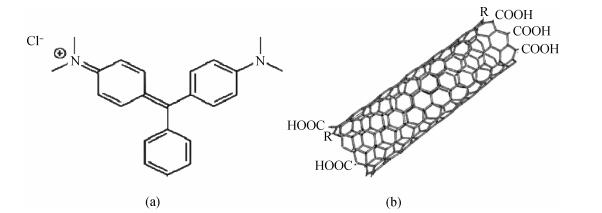
 DownLoad:
DownLoad:
